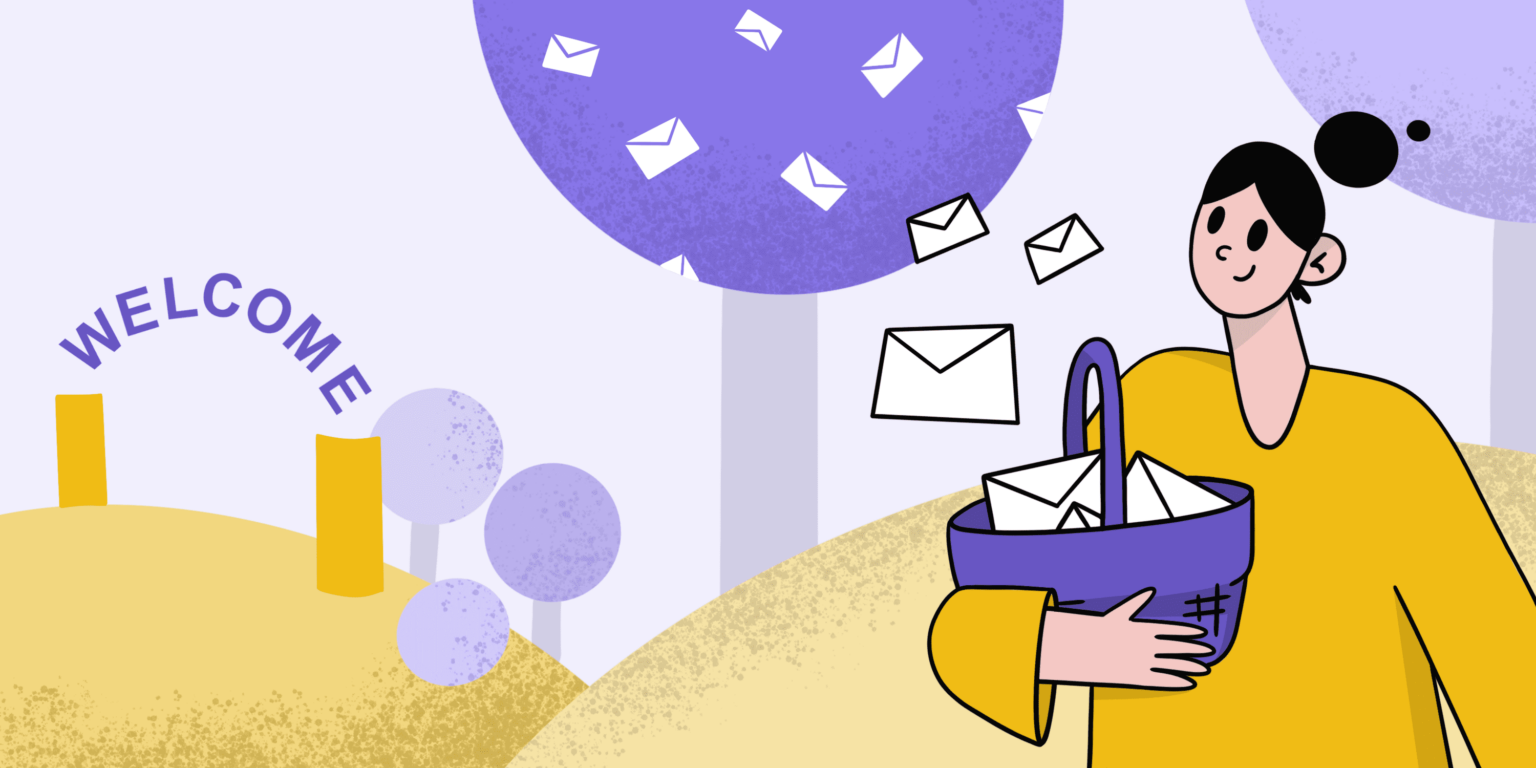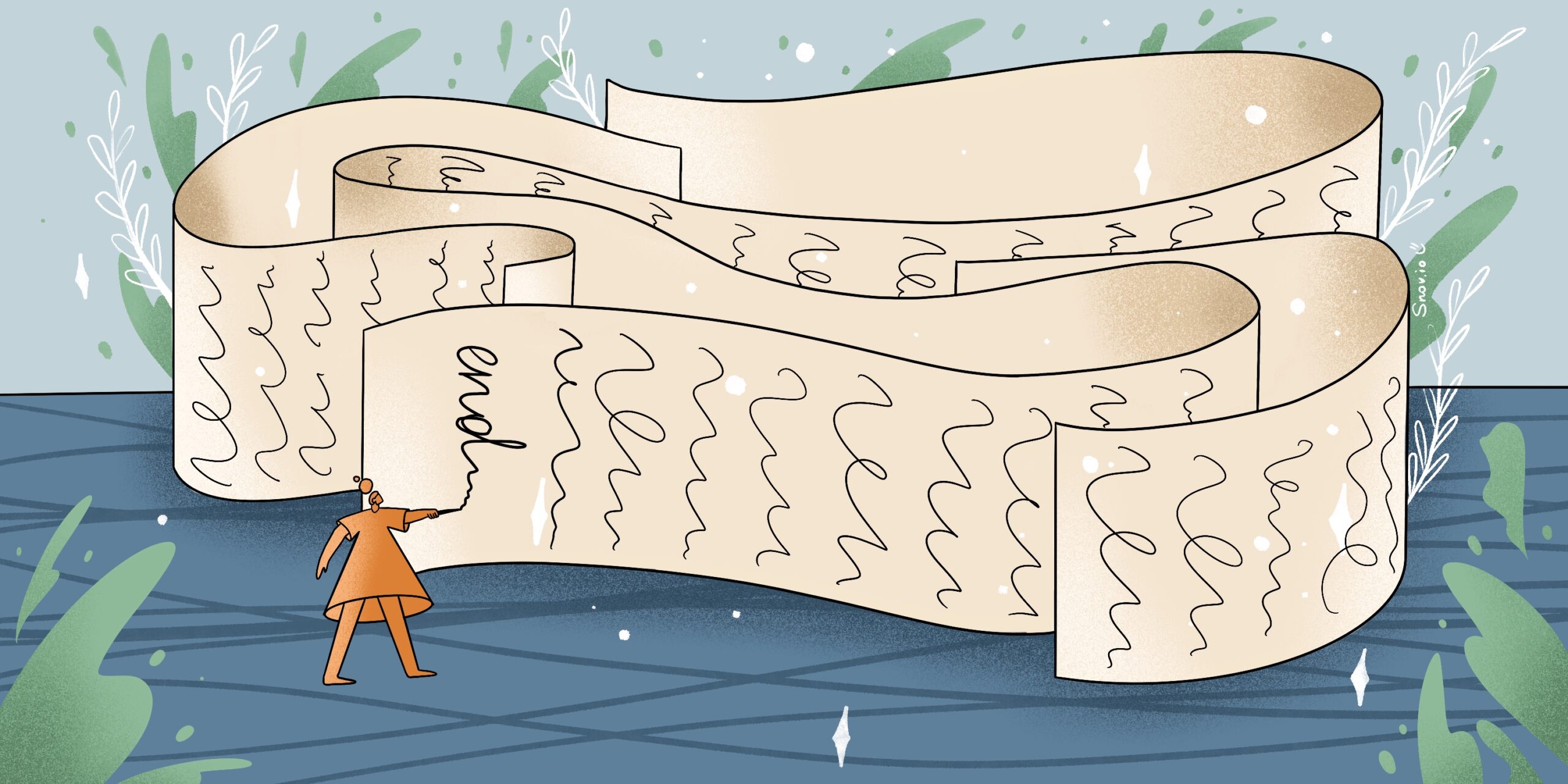You are inviting potential clients into your sales cage by sending them your best welcome email ever, but they don’t respond? What if your welcome email isn’t the best?
Let’s find a solution together. In this post, we’ve prepared ten templates with real welcome email examples to help you start a sales-growing game from an impressive introduction.
Just an impressive introduction?
Perfect welcome email design may create an impression, but will you be sending welcome emails just to catch your prospect’s eye? There are plenty of other reasons why you should elaborate on their copy. These message enable you to:
Introduce your business and product to your prospects
Welcome email is your first communication with your customers. Sending this message is that very moment your prospects become aware of your brand.
Demonstrate your attention
Sending a personalized welcome email, you’ll show you have taken time to come up with a special business relationship opening. People are attention-addicted and curious — that’s what helps welcome emails get an 82% open rate, which is about four times higher than the open rate of a standard email (24%).
Instruct your customers on how to use your product or service
In the B2B sales world, customers expect more than just attention. They want a solution that would heal their wounds. So, if you let them know how to utilize it, you’ll get many more chances to move your cooperation forward.
Communicate the value of your product or service
Your prospects will want to see the real asset behind your offer. Welcome emails are where you’ll be able to uncover the value of your solution from the very beginning.
Express your ‘Thank you’
Let’s be honest. Not all customers are willing to subscribe to your service even if you offered them a lead magnet. Appreciate those who joined you. Your welcome email is that space where you can demonstrate how much your clients mean to you and how glad you are to start cooperating with them.
Welcome email templates that grow sales
Here are ten business welcome email templates you may use to build trust with your prospects and pave the right way for growing your sales. We’ve grouped them by the main idea conveyed and supported them with examples from real email campaigns.
Welcome email templates
1. Personal touch welcome email
In 88% of cases, customers are more likely to respond to an email favorably if it looks like it’s been specifically created for them. Sending a welcome email from a real person, e.g., a company’s executive or an account manager, you’ll make your prospect feel special and valued, As a result, you’ll win their attention and loyalty to your company in the long run.
Let’s consider a welcome email template for a new customer you may use in case your email is sent from an executive:
Welcome email template #1: Personal touch
|
Dear [Customer’s name], I’m [Name], the founder of [Company name], and I’d like to personally thank you for choosing our service. We established [Company name] to [Company mission/Customer’s pain point]. To get started, take a quick look at our [Short FAQ/guide] by following this link [Respective webpage]. If you have any questions, please reply to this email. I’m here to help. Regards, [Name] [Job position] |
Now look at the real example of such a welcome email from the Co-CEO of Sendinblue:

This welcome email creates the effect of a personal touch with the prospective customer. And to be honest, if I received a letter like this, I would’ve been pleased with the attention I’ve got from the company’s highest authority.
2. Product-focused welcome email
This is the opening email for introducing your product or service. The key point here is to do it in such a way that a user could understand how to use your solution. Therefore, adding a video-guide or a knowledge base article would be the best option to help a prospect understand what your company offers.
The new customer email template you may put into your pocket in this case may be the following:
Welcome email template #2: Focus on product
|
Hi [Name], Welcome to [Company name]. We’re happy to see you among our users. [Company name] mission is to [Mission statement], so we are sure that, with our [Product/service], you can [Customer’s pain point]. Learn more about us in our video-guide, where you’ll find detailed information about our [Product/service], learn more about its features, and get tips on how to use it for your business growth. Take care! [Name] |
Of course, it can be even shorter. See how Marvel uses a welcome email to introduce their product:
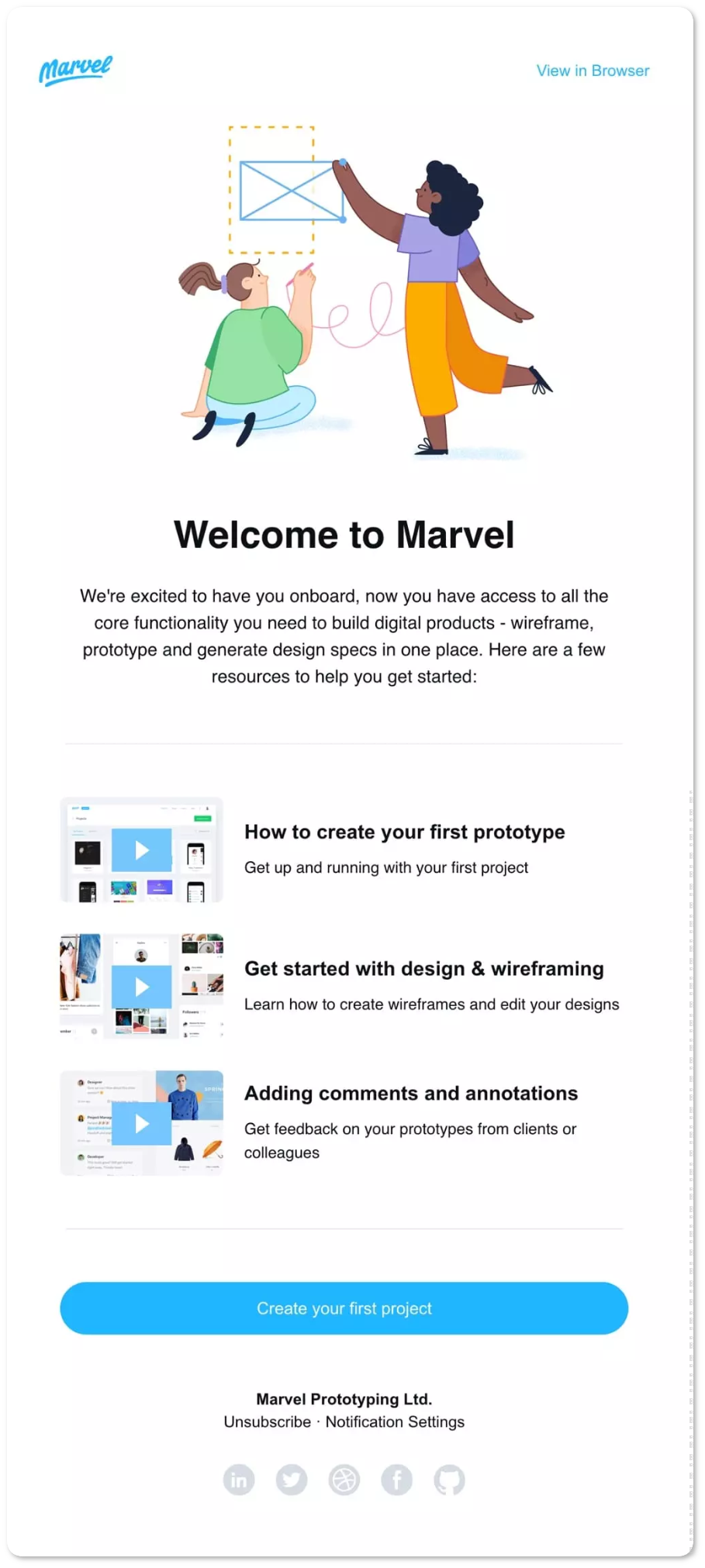
The message contains a description of their service and showcases the value it brings to their customers. After that, the company provides a subscriber with some guides on how they may create their first project. Well-done, isn’t it?
3. Free trial welcome email
This type of welcome email is sent to a potential customer who has subscribed for a free trial of your product or service. As a rule, such a letter is further followed by a series of messages encouraging prospects to subscribe to a paid plan.
Here is a corresponding welcome email template for a new customer:
Welcome email template #3: Free trial
|
Hi [Name], Thanks for signing up for [Your product/service]! Welcome to your free trial that starts today. Over the next [Length of trial], you’ll be sent emails with tips on how to use [Your product/service]. Check your inbox for updates. If you have any questions, you can contact our Support team at [Email address] any time, and they’ll be happy to assist you. Regards, [Name] |
Let’s consider a real example from CakeHR, which follows the algorithm:
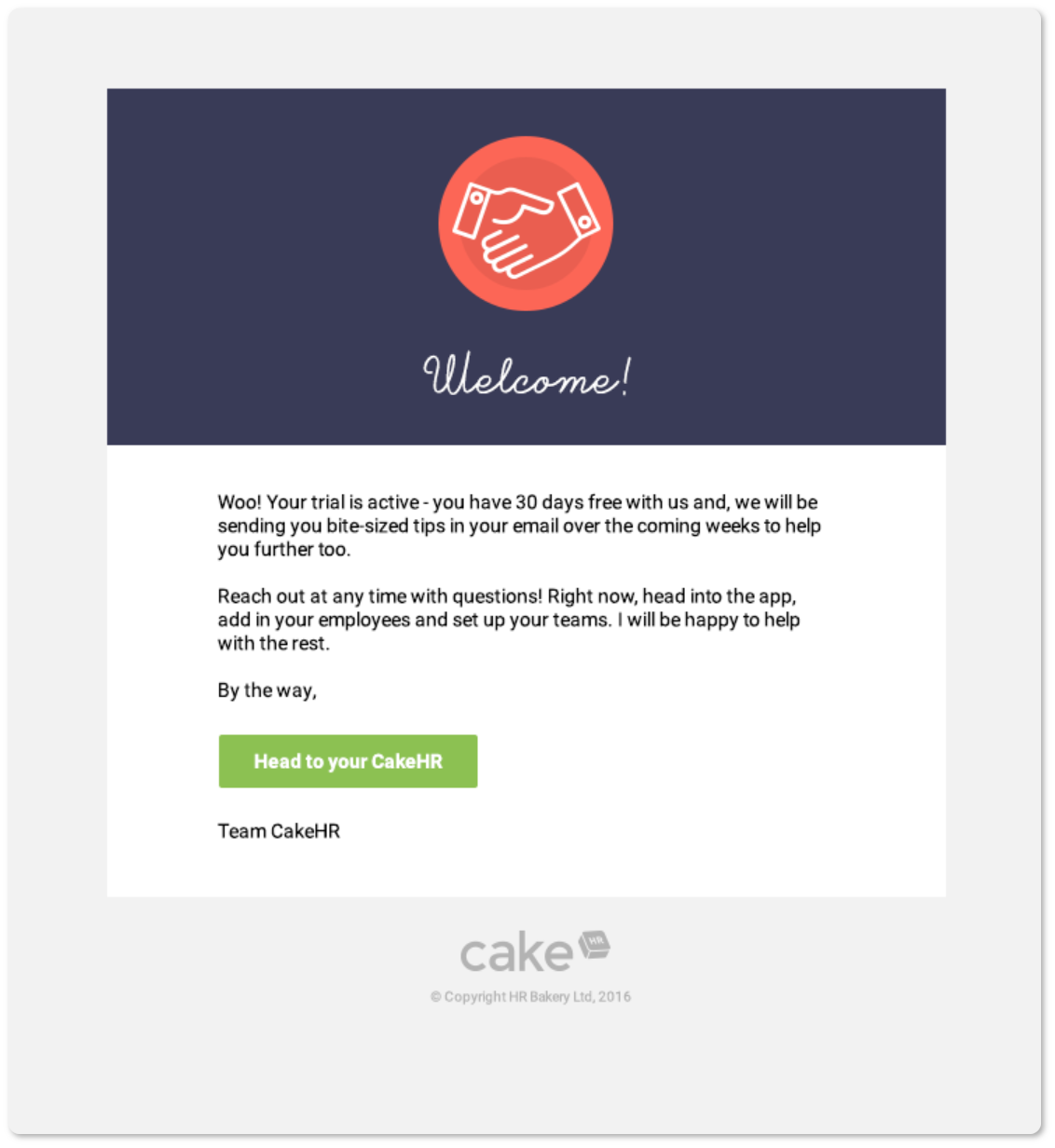
4. Post-signup welcome email
You’ll be using a “thanks for signing up” email to welcome the prospect who has subscribed to your campaigns to get some valuable content from your company, e.g., newsletters, tips, and so on.
Using this type of welcoming message, don’t be shy to introduce your product. But avoid a salesy tone that may avert your prospect from dealing with you at all.
Here is a business email template for a post-signup welcoming:
Welcome email template #4: Post-signup
|
Hi [Name], Thanks for signing up for [Newsletter name]! Here is [Content you used as a lead magnet — provided you used any]. [A link or explanation on how to get it]. Don’t hesitate to visit our blog to get more insights on [Topic] or go to [Website page] to learn more about [Product/service you offer]. Feel free to contact us at [Email address] if you have any questions. We’ll do our best to help. Regards, [Name] |
If you are running your blog, such a welcome email might be quite the case. Take a look at a “Thank you for subscribing” email example from MacPaw:
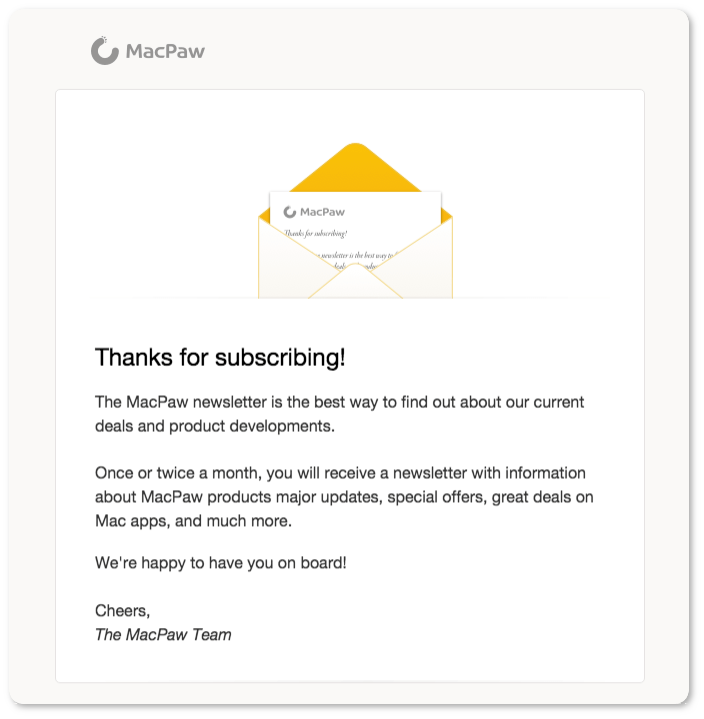
The subscriber is informed about how often they will receive a newsletter. The only thing that could be improved about the message (no doubt you already see it as well) is adding the link to the webpage where the prospect can get acquainted with the company’s offers.
5. Post-account creation welcome email
Similar to a post-subscription email, this message is aimed at welcoming new users who have created their account on your platform. Such a welcome email is typical of SaaS companies that offer personal access to their tools and features.
Welcome email template #5: Post-account creation
|
Hi [Name], Thank you for creating a [Company] account. Our company [Mention your mission and customer’s pain point]. Visit our website page [Link] to learn more about the range of our tools and features. Don’t hesitate to contact our support team at [Email address] if you have any questions. They’ll be happy to help. Regards, [Name] |
Get some insight from TweetDeck welcome email, where the company states its mission and adds a link to its website for a user to get acquainted with the service.
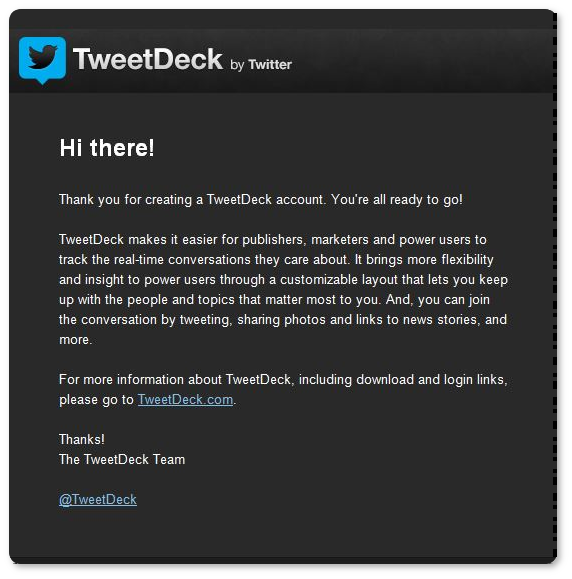
6. Post-purchase welcome email
Imagine you are over the moon because your prospect has bought your product or service. You’ve probably already sent a welcome email when they subscribed and created an account. Now it’s high time you welcome them as a customer. Thank them for a purchase and offer instructions that would guide them on how to use your service.
Consider the template you’d like to use in such a scenario:
Welcome email template #6: After a purchase
|
Dear [Customer name], Thank you for purchasing [Product name]. We believe you’ll [clarify your product’s value for the customer] using our service. To get started, take a look at our [Short FAQ/knowledge base] on how to set up and use the product properly. Should you encounter any troubles or have questions, our support team is available 24/7 at [Email or phone number]. They’ll be happy to assist you. Regards, [Your name] |
For instance, Mixpanel is never lazy to send such welcome emails to their new customers:
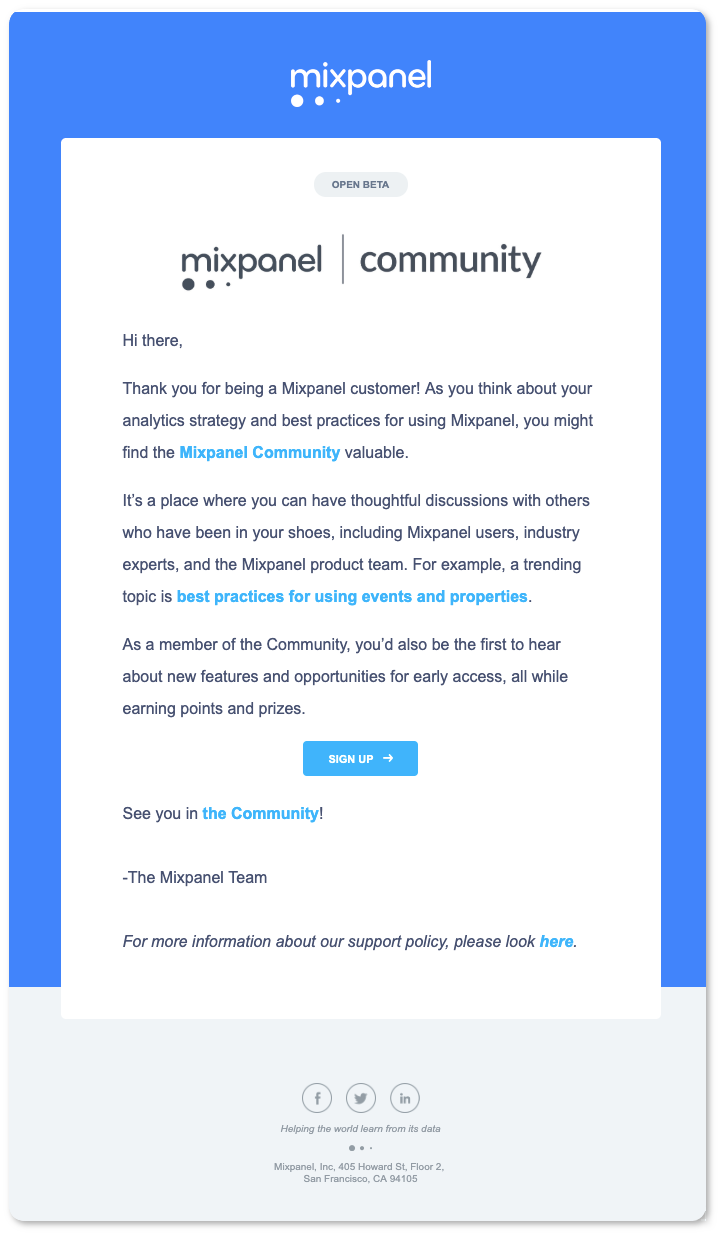
The company thanks a new client for choosing its service and provides a brief description of how it can be helpful in the future. And here comes the trick. The guys know how to make their customers feel special — they are just playing with the feeling of exclusivity (“You’d also be the first to hear about new features…”).
7. Gift welcome email
People like gifts. Around 83% of customers claim they are more encouraged to purchase a solution that presupposes a discount or promotion. And frankly, you don’t even need a special occasion to present your potential client with a free offer or coupon.
Just add one to your welcome email after your ‘Thank you for signing up’ statement, especially if your user has subscribed for a free trial. This way, you’ll win their love from the first interaction with you.
Here’s a template to help you with such a welcome email:
Welcome email template #7: Gift
|
Hi [Name], Thanks for signing up for [Your service]! We’re happy to see you among our subscribers and give you [Percentage] off for a paid plan after your free trial comes to an end. Simply use the coupon below at the checkout. [Discount code] Should you have any questions, contact our support team. They’ll be happy to assist you. Regards, [Your name] |
Squarespace is awesome with such welcome emails. Check out this one – the company announces a free trial and immediately provides a user with a discount:
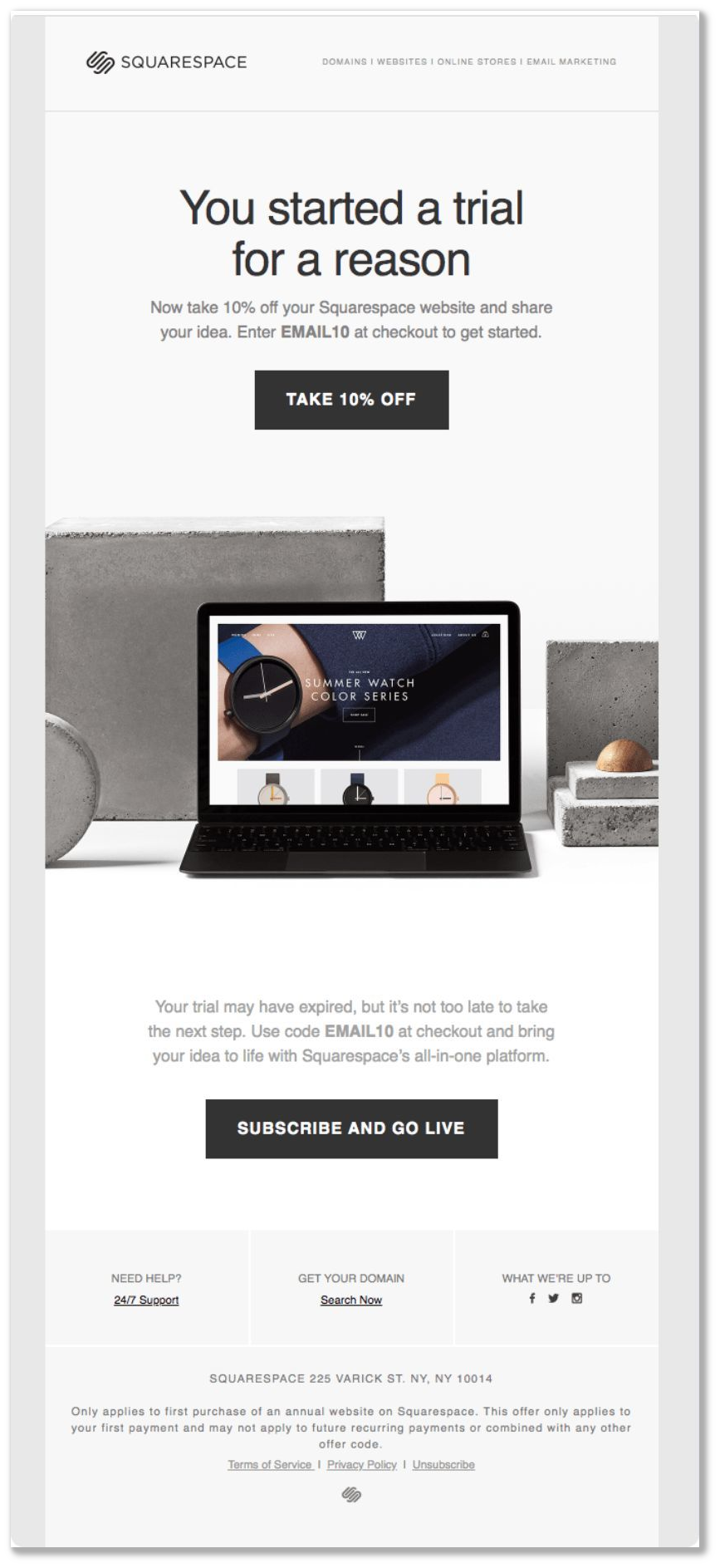
8. Onboarding welcome email
That’s the first email in a series meant to help you engage and nurture your leads. At this point you may:
- Thank them for joining your company.
- Inform them about the content you are going to send them from now on.
- Ask for their feedback to be able to segment your email list for future email campaigns.
You can find the customer onboarding email template is below:
Welcome email template #8: Onboarding
|
Hi [Name], Thanks for joining [Company name]. [Company mission statement]. We’d love to know what made you sign up for [Company]. Your feedback will help us send only relevant content to you. Would you drop us some words on that? Over the next month, we’ll be sending a few more emails for you to get maximum value from our [Product/service]. We’ll share some guidance and tips to keep you on board. Waiting for your feedback, [Your Name] |
It seems Grove follows this template like a star:
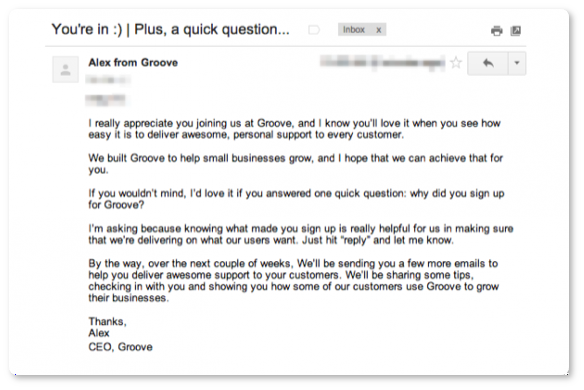
The company thanks a potential customer for a sign-in, requests their feedback, and informs them about more emails coming to their Inbox after a while.
9. Minimalist welcome email
It may seem to you that brevity is not the best format for a welcome email. After all, you are addressing the person for the first time. However, that’s not always true. The fact remains: a brief copy performs better.
The ideal length is considered to be from 50 to 125 words, as it typically results in response rates over 50% — quite encouraging! Just use a greeting, one sentence to introduce yourself, and come up with a clear CTA.
The template may look this way:
Welcome email template #9: Minimalist
|
Hi [Name], Thanks for joining [Company name]. We hope our service will [Advantage of your product]. Please, don’t hesitate to contact our support team [email] if any questions arise. Have a great start! [Your Name] |
HelloSign doesn’t bother making lengthy welcome emails. They are sure the introductory message must be simple and not boring:
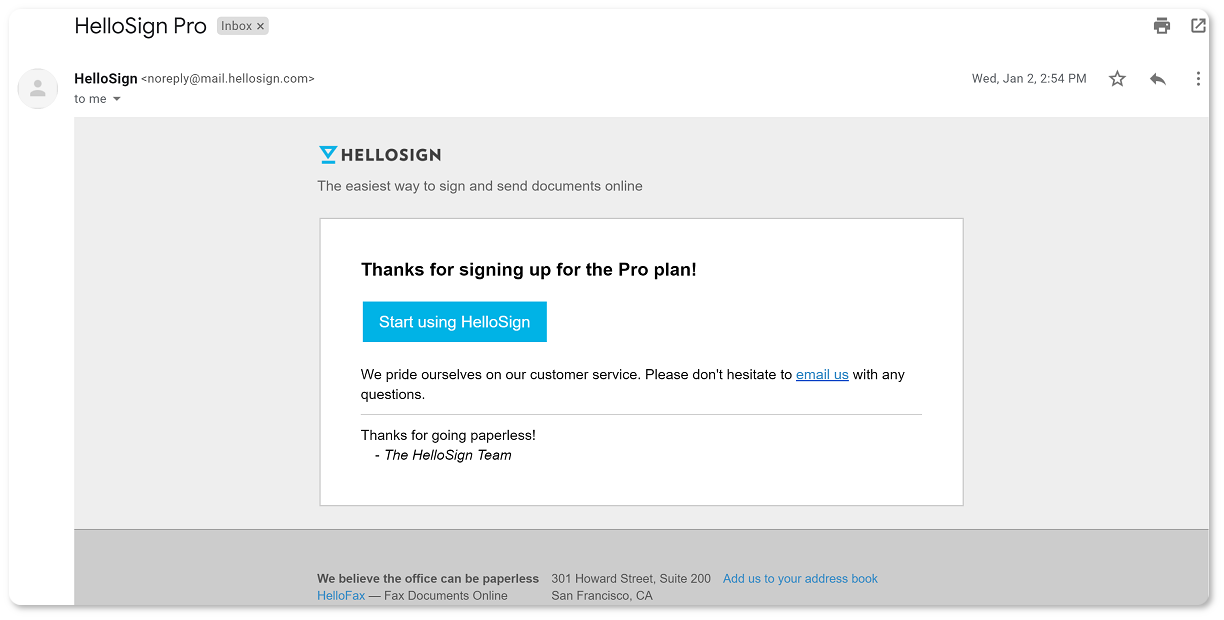
A friendly ‘Thanks’ statement, a prominent CTA, and information about the accessibility of the support team — that seems to be all a new user gets delighted with. Don’t you agree?
10. Reminder welcome email
Well, that’s not exactly a welcome email but rather a follow-up. Yet, since it is still about welcoming new users to your service, I suggest including it to our list too.
For SaaS companies like Snov.io, it’s a common practice to track how long it takes a newcomer to start using their service. So, if a user who has joined your company is still silent and hasn’t touched your tools, that’s a signal that something could go wrong. Why not welcome them again by sending a friendly reminder message?
Consider a welcoming email template you may use in such a scenario:
Welcome email template #10: A reminder
|
Hi [Name], We see that you haven’t started [Free trial/using our service]. We can’t wait to see the astounding results in your business. Simply go here [Link to login page] to get started and take a look at our [Guide/knowledgebase] to get tips on how to use our [Product/platform]. As always, our support team is here to help. Contact them at [Email address] if you have any troubles or questions. Have a nice day! [Your name] |
Let’s look at how BuzzSumo tries to keep new users in the game:
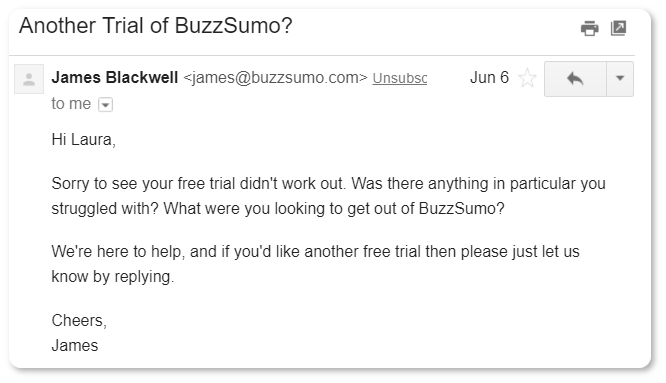
That’s a motivating example for you to never give up. Even if anything didn’t work from the start, go on. Remember that persistence is the key when it comes to your sales success.
Tips for writing an effective sales welcome email
Now that you’ve been forearmed with a good deal of welcome email templates to fit various situations, let’s crown it all with general tips on how to craft a welcoming message that could help you grow sales.
Choose the right style
There is no one-for-all recommendation on what style to apply to your welcome email. It should correspond to your company’s voice, but not sound promotional.
Now the majority of businesses avoid formality. Yet, if you are planning to contact a company among the big sharks on the market, you may start with a more formal approach and then adjust to the style this brand is using. This can include using brand colors, logos and graphics, and other branding materials.
Decide on the format
Another dilemma is whether the email should be text-based or contain images. Well, there is nothing wrong with text-based emails; however, I’m afraid that’s not the best solution for making a memorable impression.
On the other hand, if your welcome email contains images only, there is a large risk it will never reach your potential customer, as it’ll most likely land in their Promotions tab. Not the best outcome, isn’t it?
Marketing specialists found a solution, which, as they reckon, is ideal: text to image ratio in emails should be at 4:1. If you want my opinion, there is no better rule of thumb than A/B testing. By doing it from time to time, you’ll find the approach that will work best for you.
Identify the sender
As you already know, some welcome emails have more opens and clicks if they are written on behalf of an executive, e.g., a CEO. In this case, it helps communicate the company mission. And when a welcome email is signed by an account manager, it helps get to the business at once, encouraging a recipient to study the guides or start a free trial.
Make your greeting friendly
Some brands tend to greet a prospect as if they are saying a prayer (‘Our esteemed customer’ or other stuff). Frankly, I would feel sick if I were a new user.
Professional doesn’t mean insincere. Opt for tone-downed greetings such as ‘Welcome aboard’ or ‘Thanks for choosing our company.’ They will sound much friendlier.
Communicate your value
The evil of being too promotional in your welcome email doesn’t mean you should be silent about your product value. State how your product or service may be helpful, e.g., “Our tools will help you generate more leads and scale your business.”
Encourage customers to contact you
To build trust, you need to demonstrate to prospects you are open to their questions and ready to help out in case any problems occur, especially when it comes to SaaS companies.
Believe me, even the wittiest users will find some hurdles as soon as they start using your software. Mention you are always here to assist them and don’t forget to give your contact details (email or the phone number).
Provide necessary resources
Say, if you have promised some kind of perk for the subscription, your welcome email must contain instructions on how your new user can get it. The same goes for gifts and guidelines.
You have chosen the gift-strategy for your welcoming message? — Great. Explain how a prospect can use a discount or a coupon.
You wish to help a new user not get lost while trying your service? — Cool. Then give them the links to tutorials or your knowledgebase.
Wrapping up
Welcome emails are your first interaction with your potential customer. That’s a chance for you to introduce your company and create an astounding impression, the one that would motivate your prospect to try your offer.
We have collected a dozen welcome email templates to help you build your messages. Still, there is no ideal solution to fit all cases. That’s where your experience will show you the right way… Conduct thorough email search, use email checker to verify your prospect list, and segment your list to come up with the welcome email strategy that would help you grow your sales.
And remember learning your sales ABC with Snov.io. From lead generation to sales closing, this platform is always on guard duty to help you sleep well while your sales process is in action.
